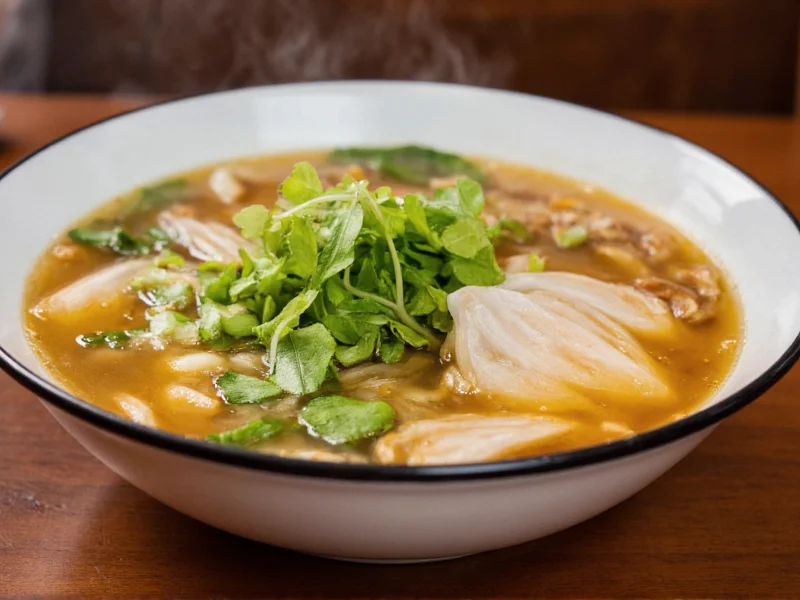Understanding what makes authentic Vietnamese pho broth soup special requires appreciating both its culinary technique and cultural significance. Unlike standard Western broths, pho broth achieves its distinctive flavor profile through meticulous preparation rather than heavy seasoning. The magic happens during the extended simmering process where collagen from bones transforms into gelatin, creating that signature silky mouthfeel while extracting deep umami flavors.
The Cultural Heart of Vietnamese Cuisine
Pho broth isn't merely a soup base—it's the soul of Vietnam's most beloved culinary export. Originating in northern Vietnam during the early 20th century, pho broth soup evolved from French colonial influences meeting traditional Vietnamese bone broth techniques. Street vendors would simmer bones overnight, creating an aromatic elixir that became the centerpiece of morning meals across the country. Today, mastering traditional pho broth preparation remains a point of pride for Vietnamese families and restaurants worldwide.
Essential Components of Authentic Pho Broth
Creating genuine pho broth requires attention to three critical elements:
| Component | Traditional Ingredients | Modern Shortcuts (Less Authentic) |
|---|---|---|
| Bone Base | Beef marrow bones, knuckle bones, oxtail | Pre-made broth concentrates |
| Aromatics | Charred onion, charred ginger | Raw onion and ginger |
| Spice Bundle | Whole star anise, cinnamon sticks, cloves, cardamom | Ground spices or pre-mixed packets |
What Gives Pho Broth Its Distinctive Flavor Profile
The unique taste of traditional Vietnamese pho broth comes from several carefully executed steps:
- Charring aromatics—Onions and ginger are blackened over open flame or in a dry skillet, creating complex caramelized notes without bitterness
- Spice toasting—Whole spices are briefly toasted to release essential oils before adding to the broth
- Layered simmering—Bones simmer first to extract collagen, then aromatics and spices are added at precise intervals
- Skimming discipline—Impurities are meticulously removed during the first hour to maintain crystal clarity
Unlike pho broth vs bone broth comparisons might suggest, authentic pho achieves balance through restraint. The broth should showcase subtle sweetness from the bones, gentle warmth from spices, and aromatic complexity—never overwhelming any single element. This delicate equilibrium separates authentic preparation from common pho broth mistakes like over-spicing or insufficient simmering time.
Traditional Preparation Techniques Worth Preserving
While modern kitchens sometimes take shortcuts, understanding how long to simmer pho broth properly reveals why tradition matters:
- Bone preparation—Soak bones in cold water for 3-4 hours to remove blood, then blanch in boiling water for 15 minutes
- Initial simmer—Simmer cleaned bones for 3-4 hours before adding aromatics
- Spice introduction—Add charred aromatics and toasted spices during the final 2-3 hours
- Final clarification—Strain through cheesecloth, then simmer broth alone for 30 minutes to concentrate flavors
This traditional pho broth preparation method creates a broth that's simultaneously rich and delicate—a hallmark of authentic Vietnamese cuisine. Many home cooks mistakenly believe adding fish sauce or sugar early enhances flavor, but these should only be adjusted in the final bowl to preserve the broth's nuanced character.
Evaluating Quality Pho Broth
When assessing how to identify authentic pho broth, look for these characteristics:
- Clarity—Should be transparent, not cloudy (achieved through careful skimming)
- Aroma—Complex but balanced scent featuring star anise and cinnamon without overpowering
- Mouthfeel—Silky texture from properly extracted collagen
- Taste—Harmonious blend of savory, sweet, and aromatic notes that doesn't require additional seasoning
Many restaurants compromise authenticity by using commercial bases or insufficient simmering time. True homemade pho broth without shortcuts requires patience but delivers an unparalleled depth that defines the dish.
Preserving Tradition in Modern Kitchens
While pressure cookers can reduce how long to make pho broth from 12 hours to 90 minutes, they often sacrifice complexity. For those seeking authentic Vietnamese pho broth recipe guidance, consider these recommendations:
- Use at least 50% marrow bones for optimal gelatin extraction
- Char aromatics until deeply browned but not completely blackened
- Simmer spices in a muslin bag for easy removal
- Maintain a gentle simmer—never a rolling boil—to prevent cloudiness
- Taste and adjust seasoning only after the full simmering process
Understanding these nuances transforms pho broth soup preparation techniques from a simple cooking task into a meaningful culinary tradition. Whether making Vietnamese beef pho broth vs chicken pho broth, the principles remain consistent—respect the ingredients, honor the process, and appreciate the cultural heritage in every bowl.
What's the difference between pho broth and regular bone broth?
Pho broth features specific Vietnamese spices like star anise and cinnamon added at precise times during simmering, creating a distinctive aromatic profile. While both use bones, pho broth requires charred aromatics and follows a multi-stage simmering process that regular bone broth doesn't, resulting in a clearer, more delicately spiced broth.
How can I make pho broth clear and not cloudy?
Start with cold water, bring to a gentle simmer (not boil), and meticulously skim impurities during the first hour. Blanching bones beforehand and avoiding vigorous boiling throughout the process ensures crystal-clear broth. Straining through cheesecloth provides final clarification.
Why are onions and ginger charred for pho broth?
Charring creates complex caramelized flavors through the Maillard reaction while removing raw pungency. The blackened exterior adds subtle smokiness and deepens the broth's color without bitterness, a technique unique to authentic pho preparation that distinguishes it from other broths.
Can I make authentic pho broth in less time?
While pressure cookers can reduce time to 90 minutes, traditional 6-12 hour simmering develops superior flavor complexity and texture. Shortcuts often sacrifice the delicate balance that defines authentic pho. If time-constrained, focus on proper bone preparation and spice timing to maximize flavor within your constraints.
What are the essential spices for traditional pho broth?
The core spice bundle includes whole star anise, cinnamon sticks, cloves, and cardamom pods. Some regional variations add coriander seeds or fennel seeds. Crucially, these should be used whole and toasted before adding to the broth—ground spices create cloudiness and overpowering flavor.











 浙公网安备
33010002000092号
浙公网安备
33010002000092号 浙B2-20120091-4
浙B2-20120091-4